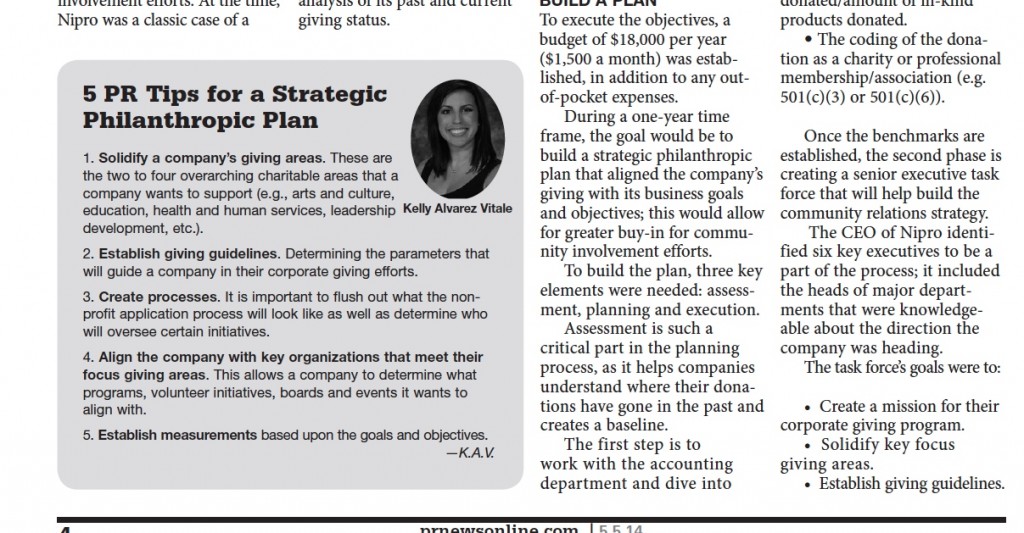Nipro Diagnostics Manufactures a Sweet (“but sugar free”)
Community Relations Plan
By: Kelly Alvarez Vitale
In 2012 corporate philanthropy, also referred to as community relations, accounted for six percent (or $18.97 billion) of the total giving in the U.S. While corporate giants account for millions in community relations efforts, the vast majority of the U.S. is made of up small/medium-sized businesses that generously give but constantly battle with how to get the most out of their dollar. Many small/medium-sized businesses justify community relations efforts as a marketing tool; however these companies can also create meaningful and strategic giving plans that emulates those of their major competitors but at a fraction of the cost.
A Sweet Deal
This change in mindset is how Nipro Diagnostics (Nipro), which manufactures glucose management systems and other diabetes products, approached their involvement efforts. At the time, Nipro was a classic case of a very generous company that had no clear strategy towards their giving and was being pulled in many directions philanthropically. In short, they were more reactive versus proactive in their approach. In addition, there was no centralized process or designated contact for community requests so the impact of their giving was being lost. Based on their giving assumptions, Nipro felt they were not large enough to justify having a full time individual to mange their community relations department. Since cost was a factor, hiring a consultant for 20 hours a month allowed Nipro to save on salary and benefits. Most importantly, the consultant was able to free up the valuable time of senior executives who were currently managing the community relations efforts. To help put structure in place, Nipro had three objectives it wanted to achieve:
- Obtain a comprehensive analysis of their past and current giving status
- Create a strategic community relations plan that aligned their giving with the company’s business goals, objectives and values
- Put systems in place to help manage and implement the day-to-day initiatives created in the plan
Manufacturing a Plan
To execute the objectives, a budget of $18,000/year ($1,500 a month) was established in additional to any out-of-pocket expenses incurred. During this one-year time frame, the goal would be to build a strategic philanthropic plan that aligned their company’s giving with their business goals and objectives; this would allow for greater buy-in for community involvement efforts. To build the plan, three key elements were needed: Assessment, Planning & Execution.
Assessment
Assessment is such a critical part in the planning process as it helps companies understand what they have donated to in the past and creates a baseline. The first step is to work with the accounting department and dive into the details. If the company has given in the past, the accounting department should be able to pull reports that include:
- Year of giving
- The name of the organization
- The amount of cash donated/amount of in-kind products donated
- The coding of the donation as a charity or professional membership/association (e.g. 501(c)(3) or 501(c)(6)
- The department or cost center where the giving was coded to
- The name of the event/program where the donation was allocated to
- The total yearly amount of employee payroll deductions for charity campaigns (i.e. United Way)
Many large corporations spend money on software programs to help track their efforts as they receive thousands of charity requests a year. Since most small/medium-sized businesses, like Nipro, may get a good number of requests a year the most cost effective way to manage the assessment process is utilizing a spreadsheet software program. If organized correctly, this program allows for it to be sorted and filtered which makes the data easy to analyze. While this task is the most time consuming, the assessment portion will give the company benchmarks that it can then track and evaluate year after year.
Planning
Once the benchmarks are established, the second phase is creating a senior executive task force that will help build the community relations strategy. The CEO of Nipro identified six key executives to be a part of the process; it included the heads of major departments that were knowledgeable about the direction the company was heading.
The task force’s goals were to:
- Create a mission for their corporate giving program
- Solidify key focus giving areas
- Establish giving guidelines
- Organize a nonprofit organization (NPO) application process
- Develop measurement assessments
Each step in the process was flushed out and agreed upon by the entire task force team. This step was extremely crucial for the buy-in from the company’s top leadership.
Execution
A plan without execution is no plan at all so it is important to make sure that a company has an individual or systems in place that can make sure the plan is implemented. The company needs to constantly be re-evaluating itself and making sure it is meeting the goals and objectives established in the plan. In Nipro’s case, they kept the consultant on board as a point of contact for all community relations efforts. Nipro decided that the consultant would have the following responsibilities:
- Serve as the point of contact for all charity requests/partnerships and volunteer opportunities
- Oversee due diligence on charity partnerships as well as tracking the impact of donations
- Manage employee engagement initiatives
- Mobilize volunteer efforts
- Establish employee recognition programs
- Assist with creating literature on corporate philanthropy efforts
- Assist with public relations coverage on community efforts
While the process seemed straight forward, challenges arose when manufacturing this plan. In this case, there were emotional ties to charities that no longer met the criteria for funding. To over come these challenges, two strategies were devised to help ease concerns.
- The company would reach out to charities that it had funded in the past and share with them the new funding criteria. The company would encourage the charity to apply if they had a program or event that aligned with the funding priorities. This would give each charity the opportunity to try and meet the criteria the community relations plan was trying to accomplish.
- Established a “Dollars for Doers” program, which incentivizes employees to participate in company-wide volunteer initiatives by rewarding them with a contribution amount (i.e. $50, $100, $250) to the employee’s charity of choice for volunteering a certain number of hours.
The task force team agreed this would be a nice transition to help both charities and employees begin to buy into the new community relations process.
Sweet Success
This process allowed the company to uncover a lot of the good they were doing but were not necessarily aware of. While their initial giving assumption was that they gave $50,000 – $75,000 on a yearly bases, in 2012 alone they donated $270,000 in cash and in-kind products to charities around the world. Of the company’s total giving, 75 percent went towards helping the medically ill and they partnered and funded 40 individual charities. In addition, the findings showed that while the industry standard is for companies to donate one (1) percent cash of their pretax profits to charitable groups, Nipro Diagnostics in fact donated three (3) percent of their pretax profits in 2012.
Other outcomes included:
- Establishing four (4) key funding priorities to help focus Nipro Diagnostics’ future giving efforts.
- Due to the number of requests Nipro Diagnostics receives, giving guidelines were created as a way to assist organizations and employees in understanding the company’s charitable priorities. These guidelines serve as an objective way the company can ward off unwanted requests but also attract appeals the company does want to receive.
- Based on the importance of the funding priorities, a budget breakdown was created to assist with sponsorship decisions and to stay within budget.
- Created recommendations for measurements of success based on the company’s funding priorities.
- Established recommendations for internal/external process for future sponsorship requests:
- This included recommendations for developing a tracking system to manage all employee involvement efforts
- Creating accountability of employee involvements
- Designing an external/internal application process for groups and/or employees soliciting requests
- Created a draft 2014 budget aligning nonprofits that best meet the company’s business goals and objectives.
Although the initial objectives of the project were achieved, the next steps are to roll out the new process to the employees and charity partners by January 2014. Leading up to the kick-off, the task force team and consultant will work to beta test several systems it is trying to implement. In addition, the team will work with the Marketing and HR departments to devise an internal campaign for the employees to excite them about the good works the company will be doing and engage them in the process.
Nipro has been an ideal case in that they have been open and receptive to bettering their community relations efforts. However a good lesson learned is sometimes change is hard to accept. It is important to understand the company’s culture and realize that certain initiatives and best practices will take time to develop and be accepted, but the most important part is to just get started.
Bio:
Kelly Alvarez Vitale is the President and Founder of Strategic Philanthropy. She started the company two years ago after being in the nonprofit arena for seven years.
Kelly@StrategicPhilanthropyInc.com
561.985.2418







